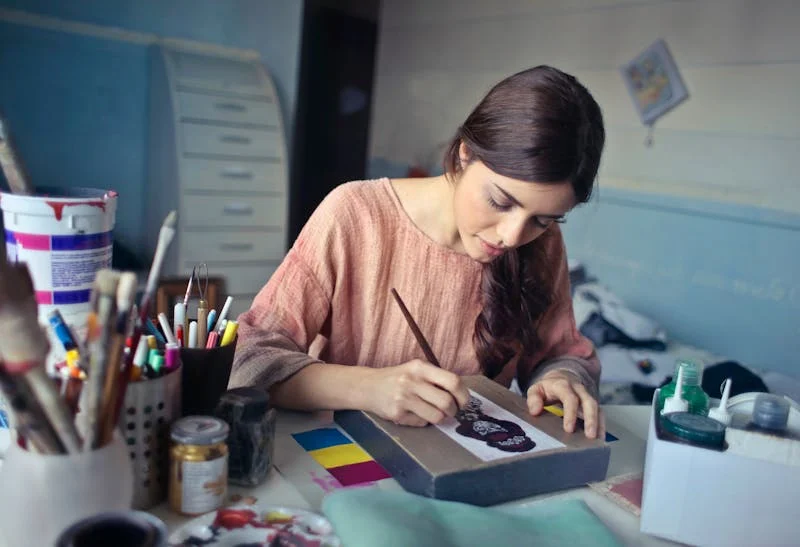
Creative Process
The journey from a fleeting idea to a finished artwork is as varied as the artists who undertake it. Each creative process is unique, shaped by personal experiences, artistic philosophies, and chosen mediums. Understanding these diverse approaches can inspire artists and art enthusiasts alike to appreciate the depth and dedication behind every masterpiece.
1. Finding Inspiration: The Seed of Creativity
Every piece of art begins with inspiration, which can strike in countless ways. Some artists find their muse in nature, others in human emotion, societal issues, or even abstract concepts.
• Observation: Many artists, like Claude Monet, draw from their surroundings, capturing fleeting moments of light and atmosphere.
• Imagination: Surrealists like Salvador Dalí harness the power of dreams and subconscious thoughts to bring their ideas to life.
• Research: Some artists, particularly those creating narrative or historical works, delve deep into studies, blending fact with their creative vision.
2. Brainstorming and Sketching: Turning Ideas into Plans
Once inspiration strikes, artists often move into the ideation phase. This step bridges the gap between abstract ideas and tangible plans.
• Sketchbooks as Laboratories: For many, sketching is a low-pressure way to experiment. Artists like Leonardo da Vinci used their notebooks to explore ideas, anatomy, and geometry.

• Mind Mapping: Conceptual artists may use mind maps or written notes to organize thoughts and refine their vision.
• Mood Boards and References: Contemporary creators often turn to digital tools, curating visual inspiration to guide their work.
3. Experimentation: Playing with Mediums and Techniques
Experimentation is crucial in honing the visual language of an idea.
• Material Exploration: Abstract expressionists like Jackson Pollock pushed boundaries by using unconventional tools and techniques.
• Color Studies: Painters often create small color studies to test palettes and refine the emotional tone of their work.
• Digital Mockups: Many modern artists utilize digital tools to experiment with compositions before committing to traditional mediums.

4. The Creative Block: When Inspiration Falters
Even the most prolific artists face creative blocks. Overcoming them often shapes the work in unexpected ways.
• Changing Perspectives: Some artists set a work aside and return with fresh eyes.
• Embracing Mistakes: “Happy accidents,” as Bob Ross famously called them, can lead to new techniques or unexpected improvements.
• Collaboration and Critique: Seeking input from peers can spark new ideas and solutions.
5. Execution: Bringing the Vision to Life
The process of execution is where ideas take their final form.
• Structured Approach: Artists like Michelangelo worked methodically, transferring precise drawings to larger canvases or sculptures.
• Intuitive Process: Others, such as abstract artists, allow the work to evolve organically, letting the materials guide the final outcome.
• Layered Development: Many painters build their works in layers, from underpainting to fine details, allowing for depth and refinement.
6. Reflection and Refinement: The Finishing Touches
Even when a piece is “finished,” many artists continue to reflect and tweak their work.
• Critique: Seeking feedback from peers or mentors can highlight areas for improvement.
• Adjustments: Small changes to color, texture, or composition often elevate the work.
• Stepping Away: Sometimes, setting the work aside offers clarity, helping artists recognize when it’s truly complete.
7. Sharing the Work: Connecting with an Audience
The final step in the artistic process is sharing the work with the world, which often transforms the artist’s relationship with it. Whether through exhibitions, social media, or private collections, art comes alive when it engages with an audience.

Conclusion
The creative process is as dynamic and evolving as the art it produces. From the initial spark of inspiration to the finishing touches, each step reflects an artist’s individuality and vision. By understanding and exploring these diverse processes, we not only gain insight into the art we admire but also cultivate our own creative journeys.
Art is not just about the final product—it’s about the story, struggle, and spirit behind it. For every piece on a gallery wall or in a digital portfolio, there’s a rich tapestry of thought, experimentation, and dedication woven into its creation.
Thanks for reading. About the author.
To read my short stories: Simply Stories



